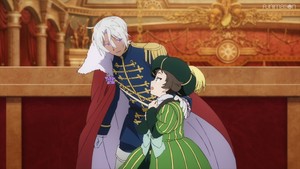The Case Study of Vanitas
Episode 4
by Rebecca Silverman,
How would you rate episode 4 of
The Case Study of Vanitas ?
Community score: 4.6

One of the most fascinating elements of The Case Study of Vanitas is the way that it takes tale types, folklore, and philosophy and twists them just a little bit to create its world and mythos. Previously we saw that with Little Red Riding Hood and werewolves, and this week, episode four brings us German Renaissance philosopher-doctor-astrologist Paracelsus. In real life, Theophrastus von Hohenheim is credited as one of, if not the, father of toxicology and a man responsible for many medical advancements, such as keeping wounds clean instead of using “treatments” that involved cow dung, among other noxious things. But he was also a great believer in astrology, like many in his time (1493[ish]-1541), and that's where Vanitas steps in. According to this week's episode, Paracelsus believed that all of life was based on formulae, and if those could be rewritten, anything was possible…and the formulae shown in the story of Paracelsus look an awful lot like the constellations in Vanitas' book. It was this rewriting that brought about vampires as a race, but it also permitted the development of the steampunk aspects of the story's world, with coal rewritten as astermite, a shining, lightweight mineral. I'm not sure how old Theophrastus would have felt about being credited with the creation of vampires, but I'm almost positive he would have loved being responsible for airships. Eat your heart out, Leonardo da Vinci.
It isn't explicitly stated, but it seems likely that the original Vanitas was a descendant of Paracelsus, or at least some kind of spiritual heir to the great man. The latter would actually make more sense, given that our Vanitas claims to be part of the clan of the Vampire of the Blue Moon, and the blue starburst tattoo on his forearm is his proof. (Oddly this is more convincing than him having the Book. I suppose the thinking is that he could have stolen it, but not faked the design on his arm.) But his motives are now even murkier than before, because his stated goal of “curing” the vampires seems to be taken by the vampires as a desire to eliminate them and turn them human, or at least more human. Since the original Vanitas would have found this reprehensible – or at least that's what we can infer from the vampires' reactions – that means that our Vanitas is essentially trying to destroy vampires by healing them, robbing them of what could be said to be unnatural. It's kind of twisted, and it definitely casts Vanitas in a much more sinister light.
That's another thing I'm really coming to like about this show: Vanitas is slowly being revealed as wearing a mask of foolishness, hiding behind his goofy actions and dumb jokes so as to conceal his true purpose. His nonreaction to Dominique chaining him to a wheel and throwing knives at him says a lot, and it's really starting to look like him forcing that kiss on Jeanne was much less of an aberration than it seemed at the time. Vanitas pushes people, seeing how far he can get them to go and then almost reveling in their breaking points. Kissing Jeanne didn't work? Then this week he'll encourage her to drink his blood to enjoy the moment when she gives in and loses control. He reacts in a combination of pleasure and pain to her giving into temptation, which once again brings us to Little Red and the sexual allegory scholars find in it, and we're forced to think about his annoyed boredom while Noé and Dominique were having their moment in the dressing room. Maybe he was less upset at being made to wait and more that he wasn't able to manipulate either of them into taking Dominique's offer to Noé farther.
In any case, the setting of a masquerade ball is perfect for the moment when Vanitas lets his own mask slip from his fingers. He's just as invested as Charlatan in creating a world of his own devising; he's just one that's more chaotic good than chaotic evil. (I'm beginning to think that there's no such thing as neutral in this show.) Masquerades have long been regarded as Carnivalesque, in the literary and philosophical sense; places where people can figuratively take off the masks they wear over their true selves by donning a costume mask. That's what both Charlatan and Vanitas seem to be encouraging people to do. The question becomes who will triumph – and whether Noé can do anything to stop them.
Rating:
The Case Study of Vanitas is currently streaming on Funimation.
discuss this in the forum (49 posts) |
this article has been modified since it was originally posted; see change history
back to The Case Study of Vanitas
Episode Review homepage / archives